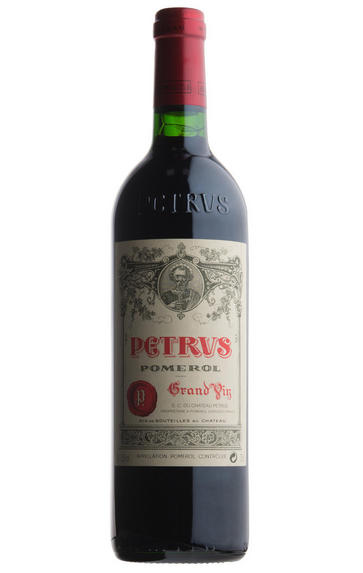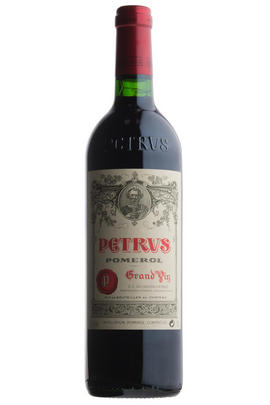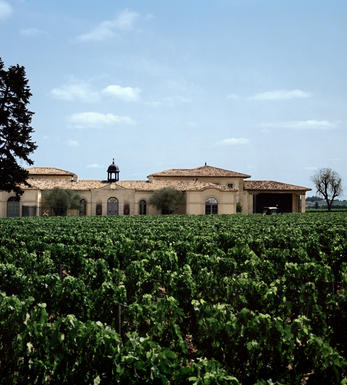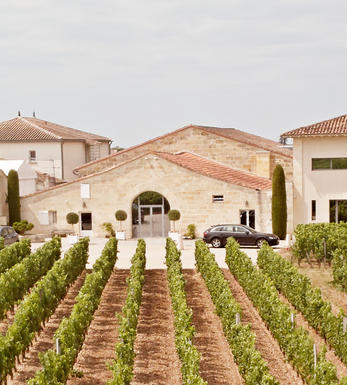
2006 Petrus, Pomerol, Bordeaux

Critics reviews
Pale to mid ruby. Pale rim. Markedly less rich on the nose than Le Pin. Almost timid in fact! Sweet palate entry and still definite structure. Very strong liquorice and still quite a bit of tannin. At quite a different evolutionary stage than Le Pin – much more youthful. Still lots of tannin and not fully resolved into a bundle of tertiary flavours. Clearly the product of marked maceration. Quite appetising but if I had one bottle I would wait for quite a time before opening it.
Drink 2020 - 2035
Jancis Robinson MW, JancisRobinson.com (January 2016)
Tasted at Bordeaux Index's annual 10-Year On tasting in London. The 2006 Petrus now seems to be evolving more slowly than the 2006 Le Pin: the fruit darker with raspberry coulis, mulberry, hints of marmalade and crushed rose petals coming forth. The palate is medium-bodied with fine tannin, gently gripping the mouth and demonstrating admirable weight and complexity. You might almost think there was some Cabernet Franc towards the finish thanks to the subtle peppery notes coming through. It is probably ready to drink now, but the substance here suggests that it will age for another decade and continue to offer pleasure long after.
Drink 2017 - 2040
Neal Martin, Wine Advocate (May 2016)
This displays green coffee bean and raspberry aromas, with a leafy undertone. Full-bodied, with refined tannins and a pretty finish. Very silky and classy. Lasts a long time on the finish. Best after 2014. 2,800 cases made.
James Suckling, Wine Spectator (January 2009)
Currently closed and backward, this wine seems to share a more similar character to Trotanoy than in any recent vintages I recall. Powerful, structured, masculine, but a long-term proposition, this dark ruby/purple-colored wine displays notes of caramelized, sweet black cherries and wild berry fruit with plenty of spice, earth, and a hint of herbaceousness.
The wine has very high tannins, impressive concentration, but that mouth-searing level of tannin. This is one Petrus that should probably be forgotten for at least 8-10 years and drunk over the following two to three decades. I always find it ironic that Petrus, which is virtually 100% Merlot, is more backward than the first growths of Medoc, which are Cabernet Sauvignon-dominated.
Drink 2017 - 2047
Robert M. Parker Jr., Wine Advocate (February 2009)
After the fabulous 2005, Pétrus again has produced a magnificent wine in 2006, even if it doesn't hit quite the same heights. It has an immensely powerful structure and concentration, always the hallmark of this wine. But this structure is almost masked by the superbly ripe and fresh fruit. And with all this weight, there is still a sense of proportion, the rich berry fruits, smokiness and light spice beautifully integrated.
Roger Voss, Wine Enthusiast (March 2009)
Bright medium ruby. Reticent but complex nose opened with air to display an almost roasted ripeness to the aromas of dark berries and licorice. Sweet, deep and lush, showing brooding dark berry and black cherry fruit sexed up by an exotic chocolate liqueur quality. A hugely rich but rather inscrutable wine. This was much deeper in pitch than the Trotanoy I tasted next to it, and missing that wine's ineffable mineral high notes, inner-mouth perfume and impression of harmoniousness. Is this simply too young to assess today? Time will tell.
Stephen Tanzer, Vinous.com (May 2009)
About this WINE

Petrus
Petrus is a wine estate in Pomerol on the Right Bank of Bordeaux. It is among the most celebrated and recognisable wines in the world.
While the estate can trace its history to at least 1837, it flew relatively under the radar until around the 20th century. Madame Loubat, who became the sole owner in 1945, felt that the estate was truly special, and her efforts were instrumental in establishing Petrus on the world stage. She also appointed Jean-Pierre Moueix as the exclusive agent; he and his sons Jean-François and Christian were key in building the estate’s modern reputation. The Moueix family became majority owners here in 1969. In 2018, they were joined by American-Colombian Alejandro Santo Domingo, who purchased a 20% stake.
Petrus is located atop the Pomerol plateau. Most of its vines sit on a so-called “buttonhole” of blue clay soil, known as smectite. This soil’s ability to retain water is a huge benefit in the Pomerol appellation, where drought is a known issue. The vineyard is planted mostly to Merlot.
The estate is run today by winemaker Olivier Berrouet, previously of neighbouring Château Cheval Blanc. Olivier joined in 2008, taking over from his father, Jean-Claude, who had produced 44 vintages of Petrus in his time.

Pomerol
Pomerol is the smallest of Bordeaux's major appellations, with about 150 producers and approximately 740 hectares of vineyards. It is home to many bijou domaines, many of which produce little more than 1,000 cases per annum.
Both the topography and architecture of the region is unremarkable, but the style of the wines is most individual. The finest vineyards are planted on a seam of rich clay which extends across the gently-elevated plateau of Pomerol, which runs from the north-eastern boundary of St Emilion. On the sides of the plateau, the soil becomes sandier and the wines lighter.
There is one satellite region to the immediate north, Lalande-de-Pomerol whose wines are stylistically very similar, if sometimes lacking the finesse of its neighbour. There has never been a classification of Pomerol wines.
Recommended Châteaux : Ch. Pétrus, Vieux Ch. Certan, Le Pin, Ch. L’Eglise-Clinet, Ch. La Conseillante, Ch. L’Evangile, Ch. Lafleur, Trotanoy, Ch. Nenin, Ch. Beauregard, Ch. Feytit-Clinet, Le Gay.

Merlot
The most widely planted grape in Bordeaux and a grape that has been on a relentless expansion drive throughout the world in the last decade. Merlot is adaptable to most soils and is relatively simple to cultivate. It is a vigorous naturally high yielding grape that requires savage pruning - over-cropped Merlot-based wines are dilute and bland. It is also vital to pick at optimum ripeness as Merlot can quickly lose its varietal characteristics if harvested overripe.
In St.Emilion and Pomerol it withstands the moist clay rich soils far better than Cabernet grapes, and at it best produces opulently rich, plummy clarets with succulent fruitcake-like nuances. Le Pin, Pétrus and Clinet are examples of hedonistically rich Merlot wines at their very best. It also plays a key supporting role in filling out the middle palate of the Cabernet-dominated wines of the Médoc and Graves.
Merlot is now grown in virtually all wine growing countries and is particularly successful in California, Chile and Northern Italy.


Buying options
Add to wishlist
Description
Pale to mid ruby. Pale rim. Markedly less rich on the nose than Le Pin. Almost timid in fact! Sweet palate entry and still definite structure. Very strong liquorice and still quite a bit of tannin. At quite a different evolutionary stage than Le Pin – much more youthful. Still lots of tannin and not fully resolved into a bundle of tertiary flavours. Clearly the product of marked maceration. Quite appetising but if I had one bottle I would wait for quite a time before opening it.
Drink 2020 - 2035
Jancis Robinson MW, JancisRobinson.com (January 2016)
wine at a glance
Delivery and quality guarantee